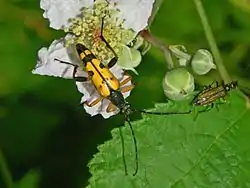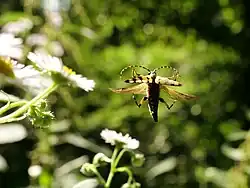| Rutpela maculata | |
|---|---|
 | |
| Rutpela maculata. Male | |
_02.jpg.webp) | |
| Female | |
| Scientific classification | |
| Kingdom: | |
| Phylum: | |
| Class: | |
| Order: | |
| Family: | |
| Subfamily: | |
| Genus: | |
| Species: | R. maculata |
| Binomial name | |
| Rutpela maculata (Poda, 1761) | |
| Synonyms | |
| |
Rutpela maculata, the spotted longhorn, is a beetle species of flower longhorns of the family Cerambycidae, subfamily Lepturinae.
Varieties
Varieties within this species include:[1]
- Rutpela maculata var. calcarata Olivier, 1790
- Rutpela maculata var. maculipes Podaný, 1950
- Rutpela maculata var. nigricornis (Stierlin, 1864)
- Rutpela maculata var. seminotata Kaufman, 1947
- Rutpela maculata var. subbinotata Podaný
- Rutpela maculata var. subsinuata Depoli
- Rutpela maculata var. undulata (Mulsant, 1839)
- Rutpela maculata var. subexternepunctata Podaný
- Rutpela maculata var. parumnotata Podaný
- Rutpela maculata var. subspinosa Fabricius, 1792
- Rutpela maculata var. subundulata Depoli, 1926
- Rutpela maculata var. subdisconotata Podaný
- Rutpela maculata var. sinuata Fabricius, 1792
Distribution
This beetle is widespread in most of Europe, in the eastern Palearctic realm, and in the Near East (Albania, Austria, Belgium, Bulgaria, Corsica, Croatia, Czech Republic, Denmark, Finland, France, Germany, Greece, Hungary, Italy, Luxembourg, Netherlands, Norway, Poland, Portugal, Romania, Russia, Sardinia, Serbia, Sicily, Slovakia, Slovenia, Spain, Sweden, Switzerland, Syria, Turkey, and the United Kingdom).[2][1]
Description


The adults grow up to 13–20 millimetres (0.51–0.79 in). The head and pronotum are dark-brown, while elytra are yellowish, with black dots and stripes, rough imitations of wasps, which probably gives them some protection from birds.[3]
Biology
Adults can be encountered from May through August, completing their life cycle in two-three years.[3] They only live two-four weeks. They are very common flower-visitors, especially Apiaceae species, feeding on pollen and the nectar. Larvae are polyphagous in deciduous trees, mainly feeding on Picea abies, Corylus avellana, Fagus sylvatica, Castanea sativa and Ostrya carpinifolia, as well as on Quercus, Carpinus, Salix, Alnus, Populus and Betula species.[1][3]
See also
- Clytus arietis, another common wasp-mimicking longhorn beetle
References
- 1 2 3 Biolib
- ↑ Fauna europaea
- 1 2 3 Hoskovec M., Rejzek M.: Longhorn beetles (Cerambycidae) of the West Palearctic region
External links